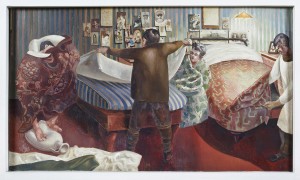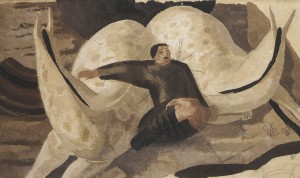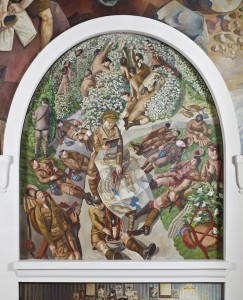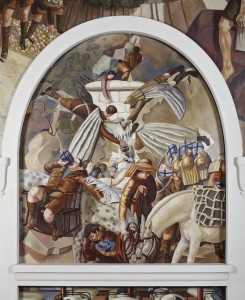
‘Stanley Spencer: Heaven in a Hell of War’, currently showing at Pallant House Gallery, Chichester, is one of the most important art exhibitions of 2014. It provides a once-in-a-lifetime opportunity to see the work of this exceptional British artist in an intimate gallery space.


First shown at Somerset House, London, the exhibition features Stanley Spencer paintings temporarily relocated from their home at The Oratory of All Souls, Sandham Memorial Chapel in the village of Burghclere, Hampshire. It also contains additional works rarely seen, loaned by Tate, the University of Chichester’s Bishop Otter Collection and private collections. The galleries at Pallant House, designed by Colin St. John Wilson, transform our experience of the works. Simon Martin, Pallant House Artistic Director, and his team are responsible for the wonderful way that these paintings are displayed. “The pictures are hung at eye level,” Simon comments, “so that the viewer is able to see details they have never seen before.”
The Oratory of All Souls was built by John Louis and Mary Behrend to honour the ‘forgotten dead’ of the First World War and they commissioned Stanley Spencer to create art for the interior, impressed by his reminiscences of the Macedonian campaign. The chapel was later dedicated to Mrs Behrend’s brother, Lieutenant Henry Willoughby Sandham, who had died of an illness contracted while serving in Macedonia. Sandham Memorial Chapel, as it subsequently became known, was gifted to the National Trust in 1947.



Spencer was inspired by the work of the 14th century Italian artist Giotto Di Bondone and it is no accident that the scheme of the chapel interior was based on Giotto’s Arena Chapel in Padua. Since the Renaissance we have become used to viewing art in frames. While the work may invite us in, we nevertheless remain the viewer. The painted medieval church is different; here we inhabit the piece of art, joined with the narratives displayed all around us. It is the gift of this remarkable show to allow us to inhabit Spencer’s narratives in this way. In viewing this art, the qualities of the aesthetic and the religious are held in tension. This shared heritage inspires a vital experience.
The pictures were painted from memory on canvas between 1927 and 1932. They reflect Spencer’s very particular perspectives resulting from his experience of war and are a fulfilment of an idea conceived while he was on active service between 1914 and 1918. Writing home, Spencer said, “We are going to build a church and the wall will have on them all about Christ.” Many artists, like C.R.W. Nevinson, Paul Nash and Mark Gertler, painted the stark reality of their experiences of the battlefield during the Great War. In contrast, Stanley Spencer’s depictions of war centre on scenes of daily life at the Beaufort War Hospital in Bristol and times between the fighting in Macedonia.
Some critics have implied a quality of escapism in these works but this is to misunderstand the integrity and Christian faith of this visionary artist at this time. Works like ‘Bed-Making’ show the domesticity and Spencer’s attempt to bring sacrifice and service into the harsh realities of the hospital and men’s injuries, as depicted in ‘Ablutions’. Stanley Spencer was influenced by St. Augustine’s writings and the possibility of holiness being lived out through ordinary, everyday tasks when carried out with the qualities of love and service. Spencer’s work speaks of the beauty and compassion in humanity, of hope, in contrast to man’s inhumanity to man.
There is no doubt that Spencer worked in a very methodical way. The sketches in the exhibition are carefully prepared with grids to enable them to be transferred accurately onto large-scale canvas panels. He would inch across the canvas, starting top left, and work meticulously, almost never retracing his work. This exhibition allows the viewer the opportunity to note some squaring through the paint.
Spencer described his method of working when he said, “I find I am painting things… in the same order in which God created them; first the firmament… then all the bare earth bits and the river bits, then the bushes and flowers and grass and trees and creepers and here I also do walls and buildings, then come animals and human beings together at the end.” His love of nature and his skill as a painter is exquisitely depicted in ‘Map-Reading’. Here the artist’s extraordinary richness of palette becomes apparent, something which is difficult to discern in the limited natural light in Sandham Memorial Chapel.
His figures are solid and sculptural, combining remembered and imagined faces and forms. His attention to detail and his handling of paint are both remarkable; take, for example, the depiction of jam sandwiches and the texture of the cloth in ‘Tea in the Hospital Ward’. Perspective and composition are carefully conceived, connecting us with these narratives. In ‘Filling Water Bottles’ the arm of the injured soldier seated in a chair leads our eye to the centre and base of the panel. To the right is a line of soldiers drinking from raised blue water bottles, conjuring the image of trumpeting angels, which together with the water from the spring draw our eyes heavenwards. The three soldiers reclining on the rocks which enfold the spring fill their bottles. They are depicted as though in flight, their cloaks drawn as angelic wings. The stone wall in its light hues seems to illuminate the scene below, while the figures above it ascend a path which rises beyond our sight, as though to heaven. The themes of forgiveness, resurrection and rebirth for all humankind run through these panels and are evident in the ‘Study for The Resurrection of the Soldiers’ from 1927. Paul Gough summarises the sacred in these works in his illuminating book ‘Journey to Burghclere’: “In Stanley’s paintings everything becomes sacred [with a] genius to make the miraculous seem normal and the normal seem miraculous.”
This exhibition runs until 15th June 2014 when the paintings will return to Sandham Memorial Chapel, which is currently closed for restoration works. Our thanks should go to Amanda Bradley and David Taylor from the National Trust, who curated this exhibition, and to Simon Martin and team at Pallant House Gallery. Together they have given us an extraordinary opportunity to view these works in an entirely different way to that which is normally possible.
Simon Martin concludes, “The 2014 Centenary of the start of the First World War provides a timely opportunity for Pallant House Gallery to present Stanley Spencer’s remarkable and visionary series of paintings inspired by conflict in [our] gallery… allowing a unique opportunity to see the paintings eye-to-eye.”
I am delighted that Toovey’s are headline sponsors, together with the Linbury Trust and the National Trust, enabling this remarkable and important exhibition to come to Sussex. For further information of talks and events relating to the show go to www.pallant.org.uk or telephone 01243 774557. The excellent catalogue of the exhibition is available from the Pallant House Gallery Shop, priced £19.95.
All images ©the estate of Stanley Spencer, 2013. All rights reserved DACs, National Trust Images/John Hammond.
By Revd. Rupert Toovey. Originally published on 26th February 2014 in the West Sussex Gazette.